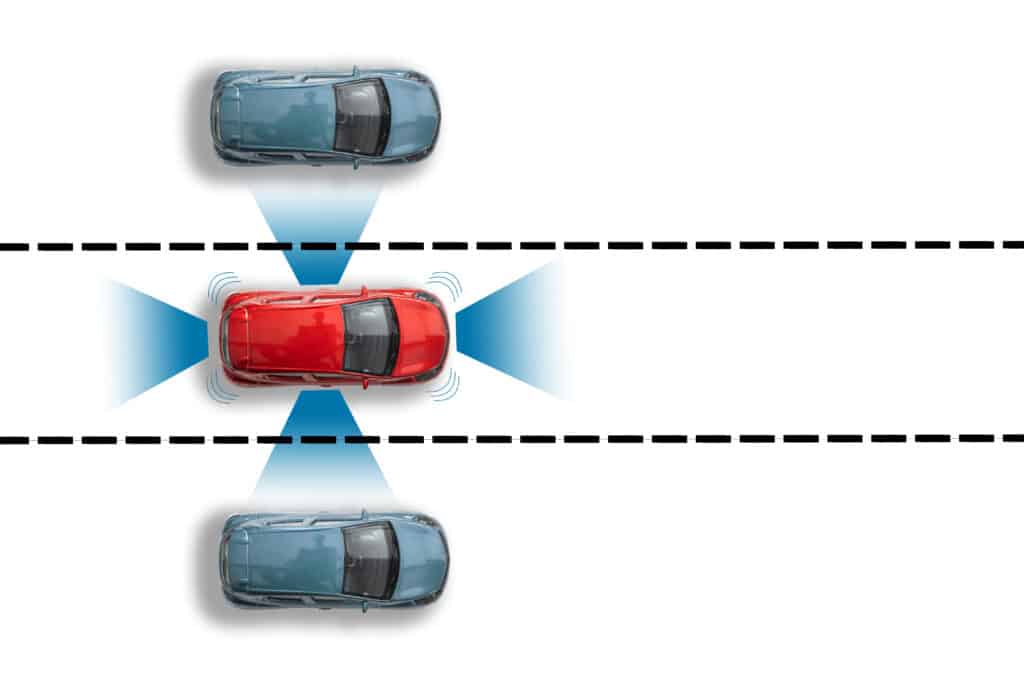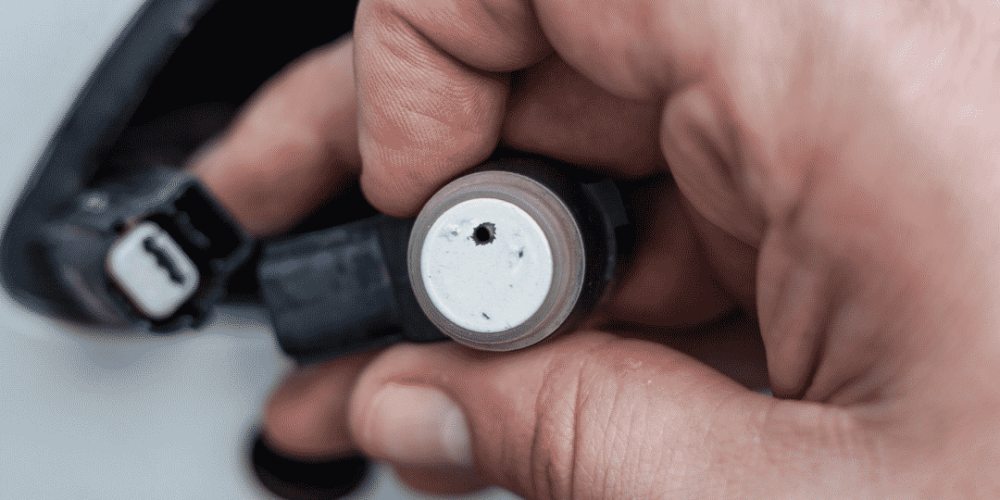Automotive radar sensors are often a vital component of Advanced Driver Assistance Systems (ADAS). ADAS radar sensors require recalibration after certain events to ensure optimal performance. In this article, we will explain what ADAS radar is, how it works, and why it’s vital to calibrate.
Radar
The word “radar” is an acronym that stands for Radio Detection and Ranging. This technology has been in use since before World War II to track the speed, position, and direction of ships and aircraft.
Radar systems emit radio waves, a type of electromagnetic energy that can be sent into the air. These signals travel at the speed of light. These waves reflect back fromobjects in the radar’s path and are processed by the radar receiver. These returned pulses enable the radar to determine the distance and position of objects, relative to the radar system’s position.
What is an ADAS Radar Sensor?
ADAS radar is an automotive radar sensor mounted to vehicles to ultimately provide drivers with safety alerts and enable safety maneuvers like Automatic Emergency Braking, Adaptive Cruise Control, Cross-Traffic Alert, and Blind Spot Monitoring.

Vehicles can have forward and rear mounted ADAS radar sensors, to inform different safety systems. Forward-facing radars are typically mounted in the vehicles front bumper or grille. They help monitor forward distance to other vehicles and obstructions. In vehicles equipped with adaptive cruise control, they also help control the following distance to forward vehicles. Additionally, the radar sensor in car bumpers are mounted in a vehicle’s rear corners help to detect closer-range objects that are approaching from the rear.
How do Automotive Radar Sensors Work?
An ADAS radar sensor uses radio waves to detect vehicles and other obstructions in the environment. The time it takes for the pulse to return allows the computer (ECU) to calculate the other vehicle’s speed and direction.
Once determined, a vehicle’s ADAS systems use that sensor information to provide you with visual, haptic or audible safety alerts. In addition, depending on the specific ADAS system technology, radar sensor data can also be of use to take temporary control of driving functions such as braking, accelerating, steering, and so on.
There are three different automotive radar ranges used:
| Range (in meters) | General Use | Placement | ADAS Systems | |
| Short Range | 0.5–20 | For detecting objects in close proximity | Rear vehicle corners | – Blind Spot Detection – Rear Collision Warning – Rear Cross Traffic Alert |
| Medium Range | 1–60 | Typically utilized by vehicles as they navigate around town because it’s more effective at detecting objects at medium distances. | Front/Varies | – Front Cross Traffic Assist – Lane Change Assist |
| Long Range | 10–250 | Typically used on highways and in specific areas with high traffic density like interchanges and junctions. | Forward facing, near the front bumper or behind the grille | – Automatic Emergency Braking – Adaptive Cruise Control (& Traffic Jam Assist) – Forward Collision Warning |
Pros and Cons of Radar for ADAS
Automotive radar, a key component of radar-based ADAS technology, is optimal for collision warning and automatic emergency braking systems. Automotive radar offers several advantages, including:
- One of radar’s main beneficial safety features is that it functions well in a variety of light conditions, such as at night or during the day.
- Radar is an all-weather solution. Operating conditions such as temperature and humidity have no effect on radar-based systems.
- Radar can easily distinguish between stationary and moving objects.
- Can detect multiple items at the same time.
Even with all the benefits radar offers, it has a few drawbacks.
- Detecting small objects with radar is difficult for shorter wavelengths.
- Existing radar-based ADAS do not work well in closed environments such as tunnels
- It can be difficult to detect an object that is static if its relative velocity is the same as the moving object.
- Interference from other radars causes accuracy problems.
Overall, radar-based ADAS systems are quite reliable and can operate in almost any situation, making them essential to modern safety systems in vehicles.
How Does Automotive Radar Compare to Other ADAS Technologies?
By definition, advanced driver assistance systems (ADAS) use sensors including cameras, lasers, and radar, to collect advanced information about the environment surrounding the vehicle. Data collected by ADAS radar sensors works in tandem with data from other ADAS sensors to provide a more complete picture of a vehicle’s surroundings.
Radar is often compared to other ADAS technologies, such as cameras and lidar. Cameras are the most common type of sensor in ADAS and they work well for detecting objects that are stationary or slowly moving. They’re not particularly good at detecting fast-moving objects because the time it takes for a camera to snap a picture is long in comparison to how quickly objects move. Lidars are like cameras, but they use light instead of radio waves. They’re also good at detecting objects in relatively close range (less than about 300 feet), but not for fast-moving or far away objects.
Radar sensors are much better at detecting moving vehicles, pedestrians, and other objects than cameras or LiDAR sensors. They can see objects that are far away and moving quickly, which is why they’re of great use in many ADAS. Radar sensors also work well in all weather conditions, including rain, snow, and fog. Cameras and lidars can’t see through most types of harsh weather.
Each sensor type has pros and cons. That’s why it’s common for automakers to include multiple types of sensors that complement each other.
Here are some pros and cons:
| Pros | Cons | |
| Radar | Detects in bad weather and in the dark | Doesn’t have high resolution at range (trouble telling bicycles from motorcycles) |
| LiDAR | High resolution at range Very accurate 3d modeling and object detection | Lesser 2D resolution than camera Can’t see through bad weather as well as radar High cost Requires significant computing power |
| Camera | High resolution Closest to human vision, detecting colors and 2D shapes Relatively low cost sensor | Sunlight can blind them Poor vision during low visibility weather Contrast is an issue Depth information not available |
ADAS Radar Calibration: Why it’s vital.
An automotive radar sensor can become misaligned due to fender benders, alignment changes, and adjacent repair work. This can cause them to give inaccurate readings. Some radar sensors are self-calibrating, but most are not…yet. Automotive radar calibration ensures that the sensor properly aligns and provides accurate information to your vehicle’s ADAS.
It is important to calibrate your automotive radar sensor after structural repairs, sensor removal or replacement, and removal of the front bumper or grille, to ensure that your car’s ADAS systems are operating as intended. If the radar is not calibrated correctly, it can provide warnings, steering, and braking interventions either too early or too late.
Calibration of automotive radar sensors is a complex process requiring a controlled environment, specialized equipment, precise measurements, and in-depth training. It’s not something you can do at home. Most auto shops don’t have the equipment necessary to handle ADAS calibrations. Due to several ADAS implementation problems, standalone calibration centers are fast becoming the solution when it comes to providing efficient, effective, and reliable calibration of ADAS sensors.
At Car ADAS Solutions, our turnkey ADAS calibration solution is tailored to your business model.
If you’re wanting to learn more about how ADAS calibrations can enhance your business, talk to us about owning your own ADAS calibration center. We are an ADAS training and consulting firm, specializing in the certification, implementation, and support of start-up ADAS calibration centers.
We provide everything you need to get your ADAS calibrations started, from hardware and software to training and support. Contact us today for more information!
Automotive Radar and ADAS Calibration FAQs
What is an ADAS radar sensor?
ADAS radar sensors are automotive radar sensors mounted on vehicles to provide safety alerts and enable features like Automatic Emergency Braking, Adaptive Cruise Control, Cross-Traffic Alert, and Blind Spot Monitoring. They can be forward or rear-mounted.
How does an ADAS radar sensor work?
ADAS radar sensors use radio waves to detect vehicles and objects. The sensor calculates the speed and direction of detected objects, enabling ADAS systems to provide safety alerts and even take control of driving functions.
What are the different ranges of automotive radar sensors?
There are three radar ranges: Short Range (0.5–20 meters) for close proximity, Medium Range (1–60 meters) for medium distances, and Long Range (10–250 meters) for highways and high traffic areas.
How does radar compare to other ADAS technologies like cameras and LiDAR?
Radar excels at detecting moving objects, works well in all weather conditions, and sees far and fast. Cameras are good for stationary objects but have limited visibility in bad weather. LiDAR is accurate but has range limitations.
Why is ADAS radar calibration essential?
Radar sensors can become misaligned due to accidents or repairs, leading to inaccurate readings. Calibration ensures correct that the sensors are functioning properly.
When should I calibrate my automotive radar sensor?
Calibration is necessary after structural repairs, sensor replacement, or removal, and bumper or grille removal. Incorrect calibration can lead to untimely warnings or interventions.
Do auto shops provide radar sensor calibration?
Most auto shops lack the equipment for ADAS calibrations, leading to standalone calibration centers as a solution.







